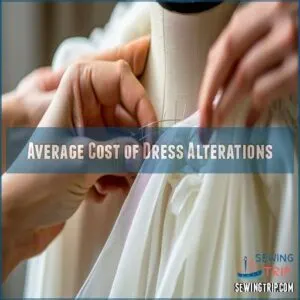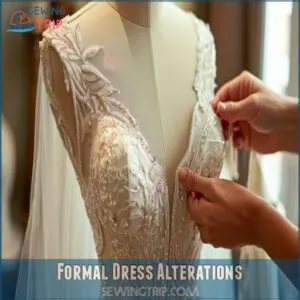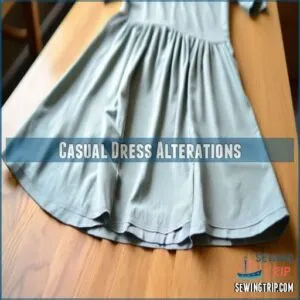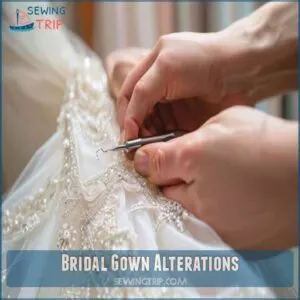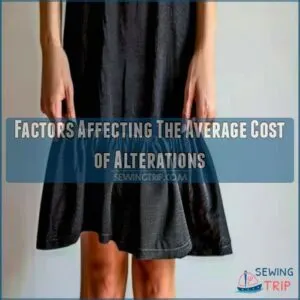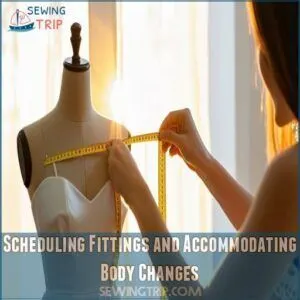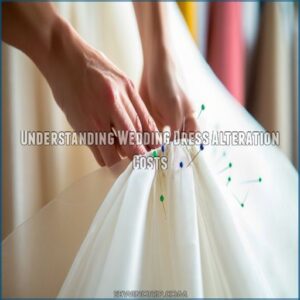This site is supported by our readers. We may earn a commission, at no cost to you, if you purchase through links.
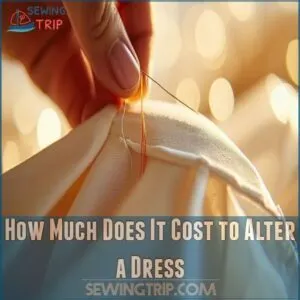
Simple tweaks might just require a bit of pocket change, but complex alterations—like taking in bridal gowns—can tip the scale higher.
The type of fabric, complexity of the job, and where you live also play a part in the pricing game.
Always ask for an estimate before those scissors start snipping. And if you’re curious about saving a few bucks without sacrificing style, our next tips could be your ticket to alteration bliss!
Table Of Contents
- Key Takeaways
- Average Cost of Dress Alterations
- How Much Does It Cost to Alter a Dress
- Types of Dresses and Alteration Costs
- Factors Affecting The Average Cost of Alterations
- Finding a Reliable Seamstress for Your Dress
- Tips for Brides on Wedding Dress Alterations
- Understanding Wedding Dress Alteration Costs
- Getting Your Dress Altered on Time and Budget
- Frequently Asked Questions (FAQs)
- Conclusion
Key Takeaways
- You should expect to pay between $50 and $200 for most dress alterations, but bridal gowns and complex fabrics can cost significantly more.
- Factors like fabric type, alteration complexity, and location influence costs; metropolitan areas typically have higher rates.
- For basic alterations like hemming, prices range from $30 to $120, while extensive bridal gown modifications start at $200 and can exceed $800.
- Always get an estimate before alterations begin, and consider getting multiple quotes to ensure you’re getting the best value.
Average Cost of Dress Alterations
You’ll find that most dress alterations cost between $50 and $200, depending on the complexity of changes needed and the type of dress you’re modifying.
If you’re planning to alter a wedding gown, you can expect to pay more, with basic bridal alterations starting at $200 and potentially reaching $800 for more extensive modifications.
Factors Affecting Costs
Getting your dress altered isn’t just about the basic costs – several key factors influence what you’ll pay. Think of it like customizing a car – the more complex the changes, the higher the price tag.
Here’s what affects your alteration costs:
- Fabric and construction complexity (beading, layers, delicate materials)
- Location and local market rates (city prices often run higher)
- Tailor’s experience level and specialized skills
Your dress’s material and design features play a huge role.
A silk designer gown with intricate beadwork needs more expertise than a simple cotton sundress, affecting both time and cost.
Common Alterations and Prices
Common dress alterations won’t break the bank if you know what to expect.
You’ll find most basic fixes fall into predictable price ranges, helping you budget smarter.
If you’re comfortable with DIY repairs, consider investing in a portable sewing machine, which can tackle quick fixes and fabric alterations on the go.
Here’s what top tailors typically charge:
| Alteration Type | Basic Cost | Premium Cost |
|---|---|---|
| Hemming | $30-50 | $75-120 |
| Sleeve Adjustments | $25-45 | $60-85 |
| Zipper Repair | $20-35 | $50-75 |
For bodice alterations, expect to pay between $35-85, while bustle installation ranges from $40-100.
Remember, these prices can vary based on your location and the dress’s complexity – but they’re solid starting points for your budget planning.
How Much Does It Cost to Alter a Dress
The cost to alter a dress depends on several key variables – from the complexity of changes to your location and the fabric type.
Most alterations fall between $50-$200, though prices can climb higher for designer pieces or intricate work.
To get a better idea of the prices, you can check out various products and services related to dress alterations price.
Here’s what impacts your final bill:
- Job difficulty and time required (simple hems vs. complete restructuring)
- Material type and special handling needs (delicate silks cost more than cotton)
- Your tailor’s experience level and location (city prices tend to run higher)
Before booking your appointment, always ask for an upfront estimate and discuss specific changes you need.
Types of Dresses and Alteration Costs
You’ll find that alteration costs vary considerably based on your dress type, with casual dresses typically ranging from $15 to $65 and formal gowns reaching up to $135 for basic adjustments.
Wedding dress alterations often involve extra fees or considerations, such as showing appreciation for exceptional work through tipping customs guidelines. Wedding dress alterations start at $200 and can exceed $800 for extensive modifications, but you’ll get the perfect fit that makes any special occasion even more memorable.
Formal Dress Alterations
Formal dress alterations demand precision and expertise, with prices reflecting the complexity of materials and design.
You’ll typically spend $30-$120 for hemming, $25-$65 for tapering, and $25-$135 for taking in sides.
Shoulder and strap adjustments range from $25-$55, while sleeve modifications cost $30-$55.
Professional tailors charge more for beaded gowns, layered fabrics, and intricate details that require specialized handling.
Casual Dress Alterations
Altering casual dresses costs much less than formal wear, with basic hemming running $18-65 and tapering $15-55.
You’ll find taking in a dress typically costs $18-45, while adjusting shoulders or straps ranges from $15-45.
For sleeve length adjustments, expect to pay $20-45.
Additionally, when dealing with dresses that need a more custom fit, particularly in the bust area, understanding how to make a dress bigger in the bust can be important for a comfortable and flattering fit.
When searching for a tailor, local recommendations often lead to quality work at reasonable prices.
Bridal Gown Alterations
When planning your wedding, bridal gown alterations typically range from $200 to $800 for basic changes, while custom modifications can reach $1,200.
You’ll need to budget for essentials like hemming ($120-$300), taking in the bodice, and adding a bustle.
Most brides require 2-3 fittings, starting 8-12 weeks before the big day.
Remember, complex beadwork or lace details can greatly increase these costs.
Factors Affecting The Average Cost of Alterations
You’ll find that the cost of altering your dress depends on several key factors, from the complexity of the changes to the type of fabric and stitching required.
The location of your tailor and their level of experience will also influence the final price, with urban areas and more experienced professionals typically charging higher rates.
Job Complexity and Pricing
Job complexity directly impacts your alteration costs.
Simple fixes like hemming or taking in sides might set you back $30-65, while intricate work involving beading or multiple layers can jump to $200+.
Your seamstress’s expertise also plays a role – more experienced professionals typically charge higher rates, but they’ll handle complex alterations with greater precision and skill.
Dress Type and Materials
The specific dress type and materials play a key role in alteration costs.
Designer gowns with intricate beadwork or unique embellishments can double your alteration budget compared to simpler pieces.
For knit dresses, sewing without a serger requires attention to detail, including using a ballpoint needle for knit fabrics.
Here’s what impacts your final price:
- Fabric weight (silk vs cotton)
- Lace details and placement
- Number of dress layers
- Special embellishments like sequins or pearls
You’ll pay more for formal wear alterations than casual dresses, especially with seasonal fabrics or delicate materials.
Stitch Type and Fabric Requirements
Different stitch types and fabric requirements directly impact your alteration costs.
While basic machine stitching keeps costs down, delicate fabrics often need specialized hand sewing that bumps up the price.
| Stitch/Fabric Type | Cost Range | Time Required |
|---|---|---|
| Machine Blind Hem | $15-30 | 30-60 mins |
| Hand-Sewn Hem | $45-85 | 2-3 hours |
| Beaded Fabric | $75-150 | 3-4 hours |
Your fabric’s weight and complexity determine the thread type and needle size needed, affecting both time and cost.
Location and Business Costs
Looking for dress alterations in a major city? You’ll likely pay more than in smaller towns.
Urban tailors face higher rent and operating costs, which affects their pricing.
While Manhattan seamstresses might charge $200 for basic alterations, the same service in rural areas could cost half that.
Your local market’s cost of living and demand for alterations services directly influence what you’ll pay.
Tasker Experience and Reputation
Seasoned seamstresses command higher rates for dress alterations, but their expertise often justifies the investment.
You’ll find that experienced tailors typically charge 20-30% more than newcomers, reflecting their refined skills and proven track record.
When checking reviews and portfolios, prioritize professionals who specialize in your dress type – formal, casual, or bridal.
Their reputation and referrals speak volumes about their craftsmanship.
Finding a Reliable Seamstress for Your Dress
You’ll need a skilled seamstress who can handle your dress alterations correctly while staying within your budget and timeline.
Getting recommendations from other brides or checking reviews from local alteration services will help you find a reliable professional who matches your specific needs.
Visiting Dress Alteration Services
Finding the perfect tailor is like searching for a trusted partner in your style journey.
When you’re ready to visit alteration services, preparation makes all the difference in getting quality results at fair prices.
- Research local tailors thoroughly by reading recent reviews and checking their portfolios, especially for work similar to your needs
- Bring photos of your desired outcome and wear appropriate undergarments for accurate measurements
- Ask about their experience with your specific type of dress and fabric
Schedule consultations with at least three different tailors to compare their approaches, communication styles, and pricing structures before making your final choice.
Inquiring About Machine Requirements and Business Costs
When choosing a seamstress, ask about their equipment and business setup – it directly impacts your alteration costs.
Professional-grade sewing machines, specialized for different fabrics and techniques, require significant investment.
You’ll want to understand if they’re using industrial machines for formal wear or standard machines for casual alterations.
Location matters too – a downtown shop with higher rent might charge more than a home-based seamstress.
Don’t shy away from discussing their pricing strategy; experienced tailors will gladly explain how their equipment and overhead influence their rates.
Tips for Brides on Wedding Dress Alterations
You’ll need to carefully examine the existing seam allowances and consider techniques like letting out seams for comfort to adjust the fit of your dress before alterations. You’ll need to plan your wedding dress alterations carefully to guarantee the perfect fit for your big day, and knowing what to expect can save you time and money.
From scheduling multiple fittings to bringing your wedding shoes and undergarments, these practical tips will help you navigate the alteration process with confidence.
Scheduling Fittings and Accommodating Body Changes
A successful dress fitting starts with smart scheduling.
You’ll want to map out your appointments well ahead of your big day to handle any body changes that might pop up.
Here’s what to keep in mind:
- Schedule your first fitting 8-12 weeks before the wedding
- Book a second fitting 4 weeks out
- Plan your final fitting 2 weeks before
- Allow extra time if you’re expecting major body changes
- Consider monthly check-ins if you’re making lifestyle changes
Wearing Wedding Day Essentials During Fittings
Aiming for comfort? Wear your wedding day shoes, undergarments, and jewelry to fittings.
This makes sure the dress fits just right with your accessories.
Consider the dress alterations cost and shop for supplies at a trusted vendor like Everysimply.
Toss on your veil and mimic your wedding hair style, too – it’s all about getting the full picture.
Imagine painting a masterpiece; you wouldn’t dream of using half the colors.
Opting for a Hemline That Brushes The Floor
Remember those wedding photos? You want to glide, not trip!
A dress length that brushes the floor offers the perfect balance. It looks amazing, and you’ll move freely.
Consider these points:
- Easy movement.
- No tripping hazard.
- Elegant wedding style.
Choose a hemline that skims the ground. You’ll feel comfortable and confident all day long!
Exploring Alternative Solutions for Desired Looks
Looking to save on alterations? Consider DIY alterations or a thrift store treasure for a unique touch.
Vintage dress options, which often feature delicate fabrics that may require silk lining alternatives, can be stunning with a bit of fabric manipulation and color adjustments.
Let style inspiration fuel your creativity.
Whether adding lace or changing hemlines, small tweaks can transform your gown and keep your budget in check.
Understanding Wedding Dress Alteration Costs
When you’re looking to get your wedding dress altered, you’ll find that costs can range from basic adjustments at $80 to $800, with more elaborate changes like customizations reaching up to $1,200.
Understanding these costs will help you plan your budget effectively and make sure you get the perfect fit for your big day.
Basic Alterations and Pricing
When sorting out wedding dress alterations, you’re probably wondering about basic costs.
For a more detailed breakdown, you can find various products related to wedding dress alterations cost online.
Imagine this: hemming can run you $120 to $300, while taking in parts of the dress falls between $80 and $200.
If you need to adjust straps or shorten sleeves, expect to spend around $30 to $120.
These basics keep your gown fitting just right!
Customization Costs and Options
Now, let’s talk about customization costs and options.
If you’re considering adding embellishments or changing the sleeve style, these can range from $200 to $500.
Here are three popular customizations:
- Beading Options: Add sparkle for $250 to $600.
- Neckline Changes: Revamp for $150 to $300.
- Train Alterations: Tailor for $200 to $500.
Explore your creativity!
Flat Fees for Alterations
Picking a flat fee for alterations can save you headaches by offering pricing transparency, especially when dealing with complex adjustments like altering wedding dress necklines custom wedding dress necklines.
Think of it as a bundle deal for your dress adjustments—no surprise costs, just clear and straightforward.
Common alteration bundles cover hemming, seam adjustments, or strap tweaks.
Weigh the benefits: flat fee vs. per-item pricing helps you understand exactly where your money’s going.
Getting Your Dress Altered on Time and Budget
To get your dress altered on time and within budget, start by scheduling your fittings well in advance to avoid last-minute stress.
Consider alternative solutions like adjustable hems or minimal changes if time or costs are tight.
Allowing Ample Time for Multiple Fittings
Wedding dress alterations? Don’t get caught in a last-minute rush! Planning ahead is key. Think of your fitting schedule like a dance—it needs time to flow smoothly.
- Book your first fitting 8-12 weeks before the big day.
- Schedule a second fitting about two weeks out.
- Account for potential body changes.
- A third fitting four weeks before the wedding might be wise, especially if you’re expecting or have major alterations.
These appointments give your seamstress time to perfect your dress.
It’s all about creating the perfect fit for your special day.
Considering Alternative Solutions and Adjustments
Exploring alternatives to dress alterations can save both time and cash. Consider budget-friendly options like DIY alterations for minor tweaks or opt for a tailor’s recommendations for complex changes.
Secondhand dresses offer savings and unique styles, while rental alternatives provide chic choices without permanent commitment.
| Alternative | Benefits | Considerations |
|---|---|---|
| DIY Alterations | Cost-effective | Requires skill and tools |
| Tailor Services | Professional finish | Can be pricey |
| Secondhand Dress | Unique finds at lower costs | Limited sizing options |
| Rental Alternatives | Latest styles without buying | Limited customization |
Frequently Asked Questions (FAQs)
How much do dress alterations cost?
Dress alterations can cost between $50 and $800, depending on complexity and fabric.
Simple fixes like hemming run $18-$120, while bridal gown alterations start around $
Prices rise for intricate details, designer dresses, and urban areas.
How much does it cost to change a dress?
Altering a dress usually costs between $50 and $200, depending on the complexity and location.
Simple changes like hemming are cheaper, while intricate alterations, such as adjusting intricate designs, can push costs higher.
Always compare quotes.
How much does it cost to alter a shirt?
Shirt alterations? Think $15-$40 for simple hemming or sleeve adjustments.
More complex changes, like adding fabric or major restructuring, could easily cost more.
It depends on the tailor and the job’s difficulty.
How are alterations priced at Alterations Express?
At Alterations Express, pricing for alterations is straightforward: it’s based on the type of alteration and garment complexity.
Itemized pricing is offered for services like hemming and taking in, ensuring transparency and no hidden fees.
Why do wedding dress alterations cost so much?
Wedding dress alterations cost so much because they require skilled labor to work with delicate fabrics, intricate designs, and extensive customizations.
Each adjustment must carefully preserve the gown’s original beauty, adding to the time and complexity involved.
Why are formal dress alterations more expensive than casual alterations?
Formal dress alterations are pricier because they involve more intricate designs, delicate fabrics, and precise tailoring, often requiring expert skills.
Formal dresses demand more time and attention to detail compared to casual dresses, which are simpler to modify.
Is it expensive to tailor a dress?
Altering a dress can get pricey, especially for more complex adjustments.
It’s all about the details, fabric, and your tailor’s skills.
Expect costs between $50 and $200, but intricate work or designer brands might push it higher.
How much does it cost to alter a dress shorter?
Shortening a dress can cost you anywhere from $18 to $
It’s like cutting your morning coffee spree; it depends on the layers and fabric.
Know that a simple hem is cheaper than layered adjustments.
How much does it cost to alter the length of a prom dress?
Prom dress hemming costs vary widely. Expect to pay between $18 and $120, depending on the fabric and complexity. It’s always best to get a quote from your tailor first.
How much can a dress be altered down?
A skilled tailor can snugly alter a dress down by about one to two sizes without wrecking its shape.
However, knocking it down further may need reconstructive sewing, which could potentially mess up the design.
How do I choose the right tailor?
Find a tailor by seeking recommendations from friends, checking online reviews, and visiting local tailor shops.
Discuss your needs clearly and ask questions about their experience.
Always review portfolios and compare prices before making your final choice.
What should I bring to a fitting?
Bring your dress, shoes, and undergarments you’ll wear on the day.
Don’t forget accessories and shapewear if used.
By learning how to cinch a dress without permanent alterations, you can enhance the overall fit and create a more polished look. This helps make sure the dress fits perfectly with every element you’re planning to wear.
How are alteration costs estimated?
Dress alteration costs hinge on complexity, fabric type, and seamstress experience.
Think of tailoring like crafting a custom-made suit—hands that skillfully adjust hemlines or waistlines.
Discuss needs and snag a detailed quote upfront.
Can a dress be altered multiple times?
You can alter a dress multiple times, but be cautious.
Each alteration involves stitching that affects fabric integrity, especially delicate materials.
Over-alteration may limit future adjustments, so consult with an experienced tailor to avoid issues.
How long does a typical alteration take?
Did you know that most dress alterations take about 1 to 2 weeks?
This timeline keeps things smooth, preventing any last-minute stress.
Experienced tailors often juggle multiple projects, so early scheduling can save your nerves.
Conclusion
So, you’ve learned how much does it cost to alter a dress.
Remember, that $50 to $200 range is just a guideline.
Your specific needs—a simple hem versus a complete redesign—will drastically change the final price.
Don’t forget to get multiple quotes!
Comparing prices from different seamstresses helps you find the best value for your money.
Careful planning and clear communication are key to getting your dress altered perfectly, on time, and within budget.
Happy sewing!

